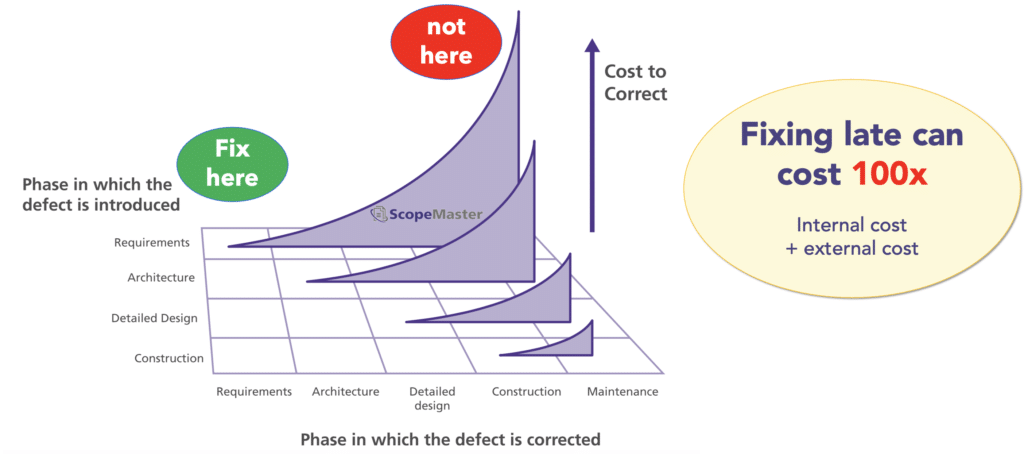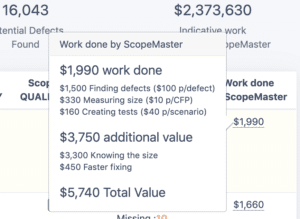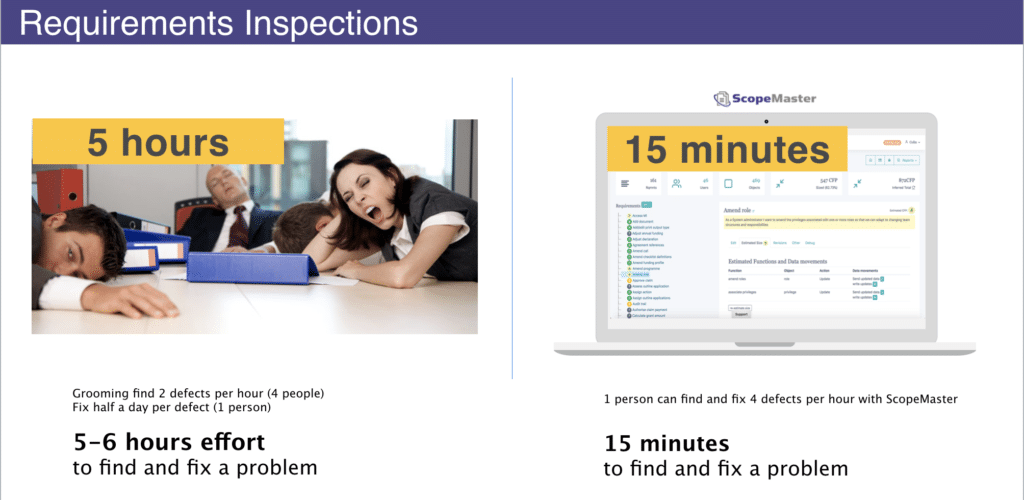Better requirements and knowledge of size helps you deliver software, faster, better, cheaper

Problems with requirements tend to be the most costly to fix. If they are undetected until later stages of the project those costs can balloon. Not only do you have repair the problems but you will incur consequential costs:
- lost opportunity costs
- reputational damage
- user compensation costs
- management distraction costs
Consider “how much more will it cost if we don’t find those requirements problems early?”
Quantifiable Benefits
- Faster and less effort to find requirements defects
- Faster and less effort to generating test scenarios
- Determining and knowing the estimated functional size
Typically 10x ROI from these benefits.
PLUS Bonus Benefits
- Better planning decisions – from knowing size
- Better project control – from tracking size
- Risk reduction – avoid scope surprises
Further ROI which can exceed 20x ROI but is harder to quantify.
Quantifiable Benefits of Using ScopeMaster
ScopeMaster typically helps you achieve an ROI of 10x or more in just a few weeks! There are further benefits, that are somewhat harder to quantify, which takes the ROI even higher.
The quantifiable benefits are based on reduced effort to find and fix requirements defects, assess functional size and generate traceable test scenarios. ScopeMaster typically performs in seconds work that might otherwise take hours to do manually. Take a set of 200 user stories, within a couple of weeks using ScopeMaster, these will be in excellent shape within 2-4 weeks of one person’s time. Whereas without using ScopeMaster, the quality scrutiny is unlikely to take place and defective requirements will lead to higher levels of rework, delay and extended bug fixing periods.
1. Finding requirements defects
Without ScopeMaster, it typically takes 2 person hours of effort o find and fix a problem during the requirements stage. The bigger the project, the harder it is to find and fix requirements problems. ScopeMaster typically finds 1-3 genuine defects per user story in seconds, that’s 2-6 hours of manual work saved. Based on an hourly rate of $50, the total benefit is $100- $300.
Average saving per user story: 2-6 hours ($100 – $300)
2. Determining and Knowing the Size
If you know the functional size of a software endeavour before you start, you can plan and manage more efficiently, allocating just the right resources and time to get the software delivered. If you are outsourcing development, just knowing the size at the proposal stage allows you to negotiate a fairer price for the development work (saving at least 10% , around $50 per CFP) or about $250 per story. In addition, the manual cost of sizing is about $10 per CFP, an average of $50 per user story. To be conservative we round this down from $300 to $200.
Average benefit per user story $200
3. Autogenerated Test Scenarios
The work normally taken to generate these test scenarios is about ten minutes per scenario. ScopeMaster generates an average of three per user story, so a benefit of 30 minutes ($50). There is further value in potentially improved coverage that might be missed if test scenarios were generated manually. We don’t include this benefit in our ROI estimate.
Average benefit per user story $50
ROI Calculation
Note that in all cases we have been conservative with our benefit estimates.
Cost of ScopeMaster per user story: $10
Cost of Staff time spent using ScopeMaster per user story: $15
Benefits of using ScopeMaster: $350 ($100 + $200 + $50)
This gives an ROI calculation of:
$350 / $25 = 14. Thats an ROI of 14x or 1400%
The benefits of requirements quality improvement alone, will give you at least a 10x ROI. And so we are confident that this is what most organisations can expect to achieve. The time it takes to learn to use ScopeMaster efficiently and then analyse a backlog of 100-200 requirements is 1-2 months. And so we typically use this as the basis of our headline benefit case of 10x within 2 months.
At least a 10x ROI, achievable within 2 months!
An ROI of over 50% is usually considered quite good for a software tool, but 1,000% (10x), is amazing and to achieve this in just two months is astounding!
But there are even more benefits of using ScopeMaster!
Additional Benefits
- ScopeMaster reduces costly change requests.
- ScopeMaster reduces bugs that affect production (caused by poor requirements).
- You benefit from delivering working solutions faster (because of less rework).
- Improved team morale because the team are working to higher quality requirements.
- Less time wasted on bug fixing.
- Reduced time coding the wrong thing (rework reduction)
- Less time wasted on writing tests for the wrong requirements and then rewriting them.
- Shorter project schedules (6%+ proven by a big 5 consultancy)
- Customer gets benefit of the software sooner.
- Outsourced development is easier to manage.
- Provides the foundation for assessing software development productivity benchmarks.
Circumstances that can increase the ROI even further
You can expect even higher benefits of using ScopeMaster if any of the following apply:
- Large projects
- Outsourced development
- BAs and Product Owners struggling to maintain quality requirements
- English is not the mother-tongue of team members, but is used as the language for requirements.
- Remote working, that leads to a greater dependency on written requirements.
- Commercial contracts are such that one party can benefit from poor requirements.
ScopeMaster delivers exceptional return on investment to organisations and teams working on software development. It will lead to clearer and more complete requirements sooner, which in turn reduces rework, reduces time wasted in meetings. Typically an agile project will spend about 20-50% of total effort on rework due to insufficient requirements knowledge. ScopeMaster mostly solves this.
Furthermore a reliable knowledge of size improves decision making, unlocking further savings in more efficient planning.
About ROI on Software Work
Here are some additional considerations about return on investment for any software. Let us start by thinking critically about how a high ROI might be possible. Software work is knowledge work that has become essential to all businesses and governments, salaries are high and the work quality is variable. Businesses invest in IT (inc software) because they expect a high return on their investment. Working software can bring incredible value to a business and its customers. The benefit (return) of having and using the software far outweighs the cost of building and maintaining it. This is why we invest in software.
What is Essential for any ROI from Software
To get the value from it, we must be very clear about what the software needs to do for the benefits to be achievable. We must also be able to quantify those benefits. In other words, we need to know what capabilities it needs to provides to users and what value it provides to them. Capabilities can be thought of as high level requirements. So, if we get the requirements wrong, we might achieve no benefit whatsoever from the software. Correct quantifiable requirements are therefore essential.
Without clear requirements, you will be wasteful and unlikely to enjoy success in knowledge work, especially software development.
If you don’t know where you want to get to, you are unlikely to get there
(adjustment of Lewis Carroll’s quote).
ScopeMaster brings automation to this neglected aspect of software work – the requirements.
The key to ScopeMaster’s high ROI is that it solves problems early that otherwise would cause costly waste and delay.
Defects in Requirements and Defects in Software
In order for software to deliver the expected value, it must be delivered as per specified. Consequently, much attention is devoted to the software working “correctly”. The requirements are considered to be the reference for what is meant by correct. And yet 15% – 30% of observed problems in production systems are caused by poor or incomplete requirements. Undermining the benefit of delivering the software in the first place.
The cost of poor requirements
On average a software requirement is 5 CFP in size, with a typical build cost of $3500. A mistaken requirement will directly cause that software needing to be rewritten, ie cost a further $3500. However if the defects are found late, even in production, and they affect users, the total cost of the poor requirement increases dramatically and becomes:
- The direct cost of the extra work to fix the requirement, architecture, design, code, tests and documentation that have already been created, incorrectly.
- The opportunity cost of fixing this problem vs working on other valuable things.
- The disruption cost of coping with the problem until it is fixed.
- The consequential cost to users of the software being wrong (maybe somebody got paid the wrong amount of money for example).
- Other consequential costs such as brand damage.
So when we think about the cost of poor requirements we need to think of them in the context of their overall impact. A requirement defect found and fixed in production may lead to tens of thousands of dollars. Whereas if the same requirement problem was fixed before any coding work started, the total fix cost may only be a hundred dollars or even less. Since the cost of a mistake slipping through into production software is so high, the corresponding benefit of finding and fixing problems early high.
Measures Value As it Goes
What’s more, it keeps track of the work it does for you. So when you use ScopeMaster, you can show your boss the valuable work it is doing to help the success of your project.

ScopeMaster calculates the value of the work it performs, as it goes.
So What?
Nowadays every company is a software company. Delivering software faster and with greater certainty is a strategic concern. Companies that do not deliver software based innovation will fall behind. ScopeMaster makes a big difference, especially on your larger (riskier) software projects. It wil reduce scope volatility, reduce rework, shorten timelines, reduce risk and much more.
Can you afford to let your competitors discover the power of ScopeMaster first?
ROI Explained
ROI assesses the benefit of an investment decision relative to the investment’s cost, calculated as the overall benefit divided by the overall cost. ROI is commonly used as a first calculation to determine the worthiness of a decision to change or make an investment. If the net benefit far exceeds the cost, the benefit can be achieved in a reasonable timeline and with few negative consequences, then it is deemed a good investment.
Total Benefit / Total Cost = ROI
Examples of ROI
Software Tooling Decisions:
Total benefit of using the tool/ cost of using the tool
Summarised ROI of using ScopeMaster
Direct Effort Saved by using ScopeMaster
- Finding defects in requirements.
- Sizing
- Generates test scenarios
= 10x ROI in less than 2 months.
Plus Consequential Benefits
- Knowing size for better project management.
- Reduced rework
- Shorter project schedules
A Case Study’s Dramatic Benefits
One case study has shown a dramatic improvement in the productivity of user story grooming activities:


“This is really neat….other than general readability, it’s the only static analysis tool for requirements that I have ever seen”

I would be shocked if this didn’t improve development team productivity by at least 10%.

This is of great potential benefit for the requirements community as well as the sizing community. I share your excitement.

Another benefit of your tool is that, not only does it interpret the requirements but it actually writes the detail specifications, which can then be used as test cases.

It is much harder to remove defects from requirements and design that it is from source code. But if those defects are not removed prior to testing, testing itself cannot find them.

Scopemaster doesn’t just help find the requirements defects but helps educate authors to prevent them in future!
ScopeMaster is an integral part of our project solution set

Its amazing that you have come up with the right set of functional requirements.

Using ScopeMaster, not only I did I find and fix 150 defects in 2 days, it was actually fun to use!
“ScopeMaster is a game changer, it’s awesome, and I continue to be blown away by what it does. I’ve said it before and I’ll say it again – I wish I’d had ScopeMaster 22 years ago”

“…I want to use it on any future projects, whether agile or waterfall, to tighten up the requirements as early as possible. To me it’s a no brainer”
“I think it’s amazing, it does so many things. Its a great tool!”

At the University of Dayton Research Institute, we pride ourselves on delivering; high-quality work, on time and budget, and having total transparency with our clients. ScopeMaster gives us a powerful tool to not only quickly and efficiently price our efforts based on industry standards but also add a new layer of customer interaction through its reports.
